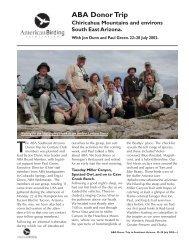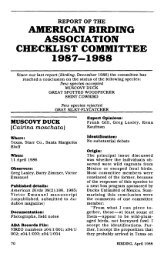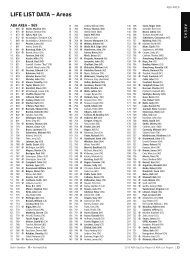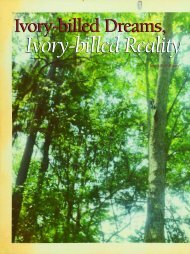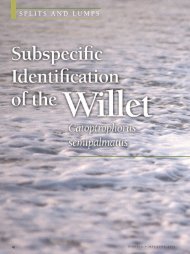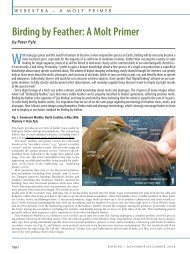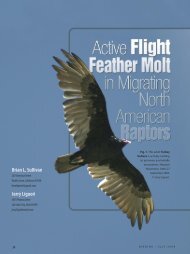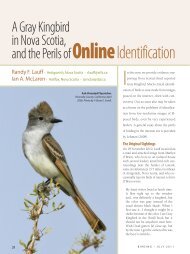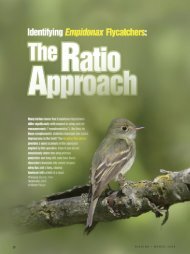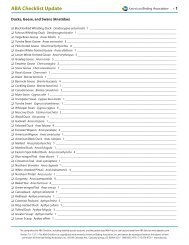Photo Essay: Redpolls from Nunavut and Greenland visit Ontario ...
Photo Essay: Redpolls from Nunavut and Greenland visit Ontario ...
Photo Essay: Redpolls from Nunavut and Greenland visit Ontario ...
- No tags were found...
You also want an ePaper? Increase the reach of your titles
YUMPU automatically turns print PDFs into web optimized ePapers that Google loves.
PHOTO ESSAY: REDPOLLS FROM NUNAVUT AND GREENLAND VISIT ONTARIOmally four plumages that may be present in a flock. As with one’s firstencounters with mixed-species flocks of rosy-finches (Leucostictespp.), sorting through the different plumages can be daunting. Articleson redpoll identification that use photographs of specimens<strong>and</strong>/or captured birds often show disheveled plumages or birds in oddposes, which can obscure some distinctions. Studying birds in life hasits challenges but is a requisite for underst<strong>and</strong>ing redpoll plumages<strong>and</strong> structures.Probably because Hoary Redpoll has been considered very rare inmost areas, observers have often assumed that birds that appeared “intermediate”between the field guide illustrations were paler-than-averageCommon <strong>Redpolls</strong>. In some cases, that may be accurate. In fieldidentification, birders frequently opt for the species presumed to bemost likely; one could say that birders often apply Occam’s razor, thelaw of parsimony, when faced with possible new hypotheses. Over thepast several decades, however, assumptions about the status, distribution,<strong>and</strong> identification of Hoary Redpoll have given way to the realizationthat even some southerly redpolls flocks (e.g., Czaplak 1995)may contain multiple Hoary <strong>Redpolls</strong>—<strong>and</strong> that few if any of thesewill be adult males. Echoing the findings of Knox (1988), Kaufman(1994) summarized the problem facing birders: “It may be that ourimage of the ‘typical’ Hoary is really based on extreme individuals.This conservative approach to identifying this species is commendablebut may skew our perception of its actual numbers, with only thepalest individuals being detected most of the time.” One might modifythat sentiment: with only the palest individuals being readily acceptedby the birding community <strong>and</strong> records committees. We may rightlysuspect that at least some birds identified in the past as “pale Commons”were instead first-year exilipes Hoary <strong>Redpolls</strong>. Of course,Common <strong>Redpolls</strong> also show variation, no less important to study <strong>and</strong>consider than variation in exilipes Hoary <strong>and</strong> other taxa.Birds of intermediate appearance have also sometimes been presumedto be hybrids. As yet, no documentation exists of either a mixed redpollpair or a hybrid in North America, <strong>and</strong> field studies suggest that nominateCommon <strong>and</strong> exilipes Hoary behave as separate species (see Molau1985, Knox 1988, Seutin et al. 1992, 1993, 1995). Detailed studies overlarge parts of these birds’ breeding ranges are lacking, however, <strong>and</strong>many questions remain unanswered; hybridization is certainly possible.Although studies have thus far detected low genetic distinctiveness betweenthe redpoll taxa (Seutin et al. 1995, Marthinsen et al. 2008), authorsof the latter study acknowledged that genetic differentiation couldbe too recent <strong>and</strong>/or rapid to be detected with the genetic markers theyinvestigated. Indeed, a recent study of the diverse Darwin’s finches detectedsurprisingly high genetic homogeneity (Freel<strong>and</strong> <strong>and</strong> Boag 1999).It is certainly possible that some birds considered “intermediates” or hybridsin the past (e.g., Wetherbee 1937) were so classed because redpolls’plumage variations by sex, age, <strong>and</strong> degree of wear were under-appreciated,as some authors have maintained (Molau 1985, Knox 1988;see Coues 1861). Birds with aberrant plumages may also pose problems.Leucistic Common <strong>Redpolls</strong> have been photographed, for instance,though such birds have shown blotchy patterns of white, rather than beinguniformly paler in plumage; nevertheless, a “dilute-plumaged” CommonRedpoll could surely be mistaken for a Hoary (Figures 3, 4). As istrue of a great many congeners, some redpolls of intermediate appearanceare best left unidentified: to record a “redpoll sp.” is to acknowledgehonestly a limit of field identification. Taking notes on such birds,photographing them, <strong>and</strong> discussing them with others is a superb wayto move the conversation forward on redpoll identification.Continued on page 212Figure 7. Distinguishing Common <strong>and</strong> Hoary <strong>Redpolls</strong> becomes most difficult when dealing with theleast-differentiated plumages, namely those of females <strong>and</strong> young birds. The larger bill, heavy brownishflank streaking, <strong>and</strong> generally brownish tones of the bird on the left indicate a Common Redpoll,<strong>and</strong> the lack of color in the breast suggests that it is not an adult male—more likely an adult femaleor a first-year bird. On the right, the tiny bill, unstreaked undertail coverts, small red “poll,” <strong>and</strong> overallfrostier tones point toward an exilipes Hoary Redpoll, but again, not an adult male, more likely a firstyearbird. In the wing, the Hoary shows more extensive white edges to remiges <strong>and</strong> coverts than theCommon. Matheson, <strong>Ontario</strong>, 18 February 2011. <strong>Photo</strong>graph by Br<strong>and</strong>on R. Holden.Figure 8. This rather streaky exilipes Hoary Redpoll, a first-year bird, shows a very limited area ofwhite in the rump, similar to many Commons. The buff tones in the cheek are more often seen infirst-year Hoaries, but some adults also have buff in the face (Lansdown et al. 1991). This bird’s verysmall bill <strong>and</strong> whitish ground color permit identification as exilipes Hoary. Once thought to be the“gold st<strong>and</strong>ard” for redpoll identification, rump color/pattern in young redpolls, <strong>and</strong> even adults,can be useful for identification, but extensive variation in both species limits its value. According toPyle (1997), the tapered rather than truncate tips of the outer three rectrices indicate a first-year(HY/SY) individual here. Matheson, <strong>Ontario</strong>, 18 February 2011. <strong>Photo</strong>graph by Br<strong>and</strong>on R. Holden.V O L U M E 6 5 ( 2 0 1 1 ) • N U M B E R 2 209



